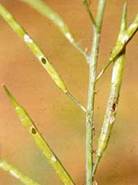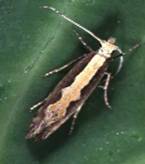Symptoms of damage:
- Whitish patches due to scrapping of epidermal leaf tissues by young larvae
- The leaves give a withered appearance but in later stages larvae bore holes in the leaves
- It also bores into pods and feeds developing seed
Identification of the pest:
- Larva: Yellowish green, with fine erect black hairs scattered all over the body
- Adult: Small greyish brown adult having pale whitish narrow wings with yellow inner margins. Forewings have three white triangular spots along the inner-margin, triangular markings of opposite wings appear as diamond shaped. Hind wings have a fringe of long fine hairs
Management:
- Installing pheromone trap @5/ac. to monitor the moth activity
- Collection and careful destruction of the larvae at gregarious stage at least twice a week
- Conserve Cotesia plutellae, as it is an important parasitoid for diamond back moth. Diadegma insulare is also the most important parasitoid of the diamondback moth
- For control of grown up larvae apply 5% malathion dust @37.5 kg/ha
|
 |
| Bore holes |
|


